
Alasdair Crockett
and David Voas (2003) 'A Divergence of Views: Attitude
change and the religious crisis over homosexuality'
Sociological Research Online, vol. 8, no. 4,
<http://www.socresonline.org.uk/8/4/crockett.html>
To cite articles published in Sociological Research Online, please reference the above information and include paragraph numbers if necessary
Received: 31/10/2003 Accepted: 28/11/2003 Published: 28/11/2003
 Abstract
Abstract Introduction
Introduction Why now?
Why now? How have attitudes
changed?
How have attitudes
changed?| Table 1. Attitudes towards homosexual practice (%) |
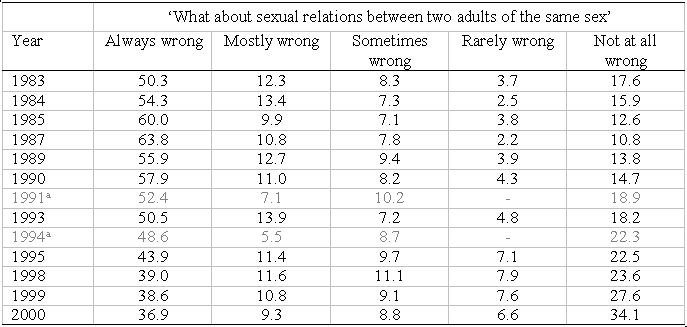
|
a The 1991 and 1994 data appear to have been coded on a four point scale without a 'rarely wrong' and 'don't know' options but with a 'can't choose' option that many (c. 11%) respondents selected. The data for these years are shown in grey to indicate a potential lack of comparability.
Note: These and all subsequent figures are based on data weighted to adjust for the different probability of selection for individuals from small and large households, and thereby make the BSA figures representative of the population of Great Britain. Responses of 'it depends' and 'don't know' are not shown and hence values do not sum to 100%.
| Figure 1. Censure of homosexuality by age, 1983 to 2000 |
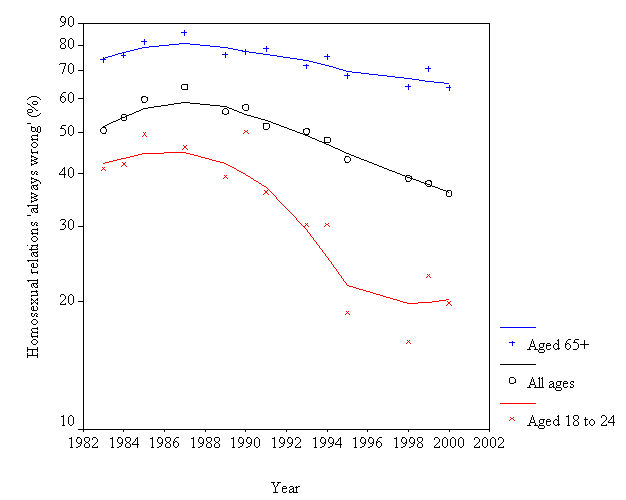
|
| Figure 2. Censure of homosexuality by sex, 1983 to 2000 |
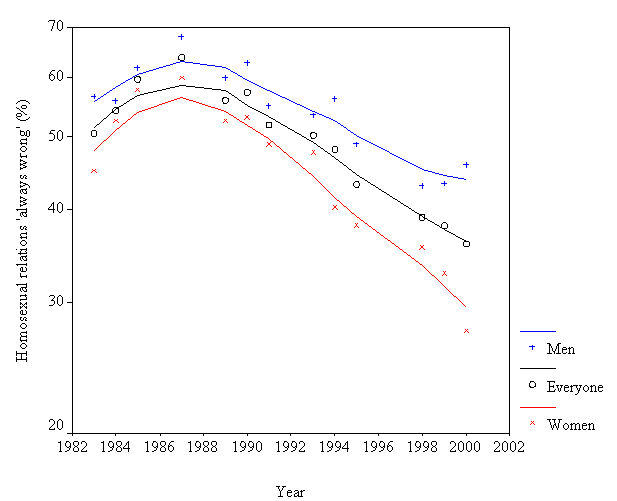 |
 Why the church
crisis?
Why the church
crisis?| Table 2. Attitudes towards homosexual practice (%): religious and non- religious |
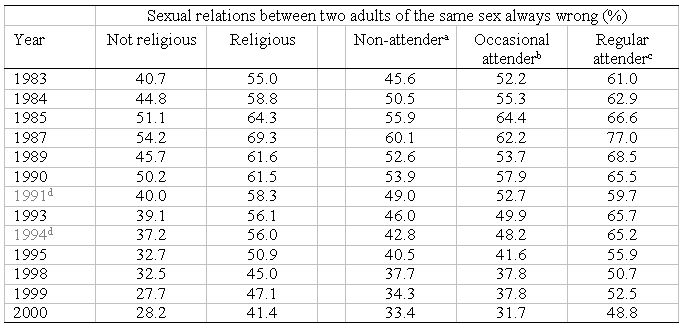 |
a Non-attendance is classed as never or almost never (the questionnaire asks respondents to exclude
attendance at special occasions such as weddings, funerals and baptism).
b Occasional attendance is classed as less than monthly.
c Regular attendance is classed as at least monthly.
d See note a to Table1 about these years.
| Figure 3. Censure of homosexuality by regularity of church attendance, 1983 to 2000 |
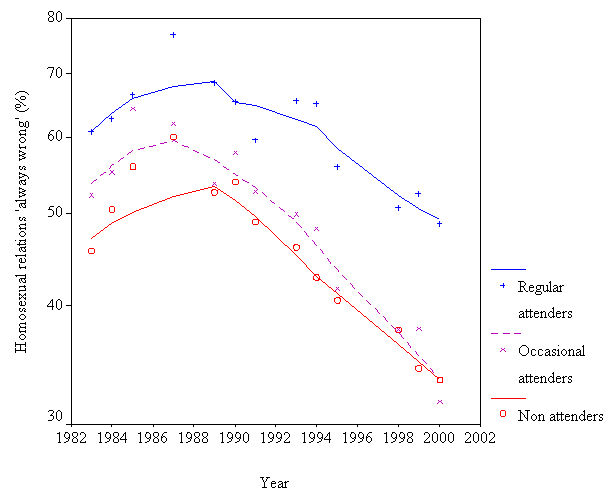 |
|
Table 3. Logistic Regression of 'anti-gay' attitudes Dependent variable: sexual relations between same-sex adults 'always wrong' (1), not always wrong (0) |
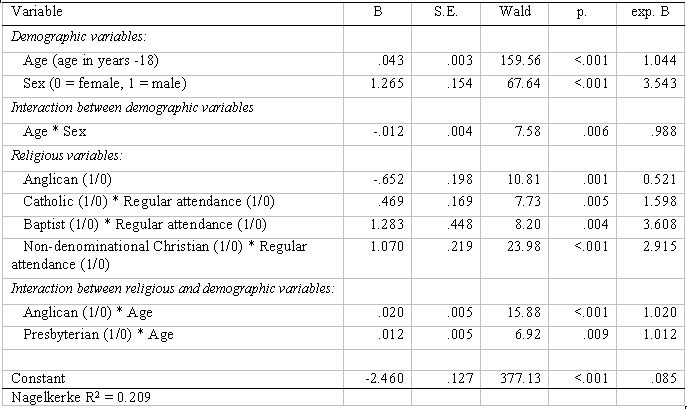
|
The variables in the table are those that were selected for analysis using a forward stepwise selection criterion (p < 0.05). For each major denominational grouping (Anglican, Catholic, Baptist, Presbyterian, Methodist and non-denominational Christian), a dichotomous variable indicating affiliation to that denomination, and interaction terms between denominational affiliation and age, male gender, female gender and regular church attendance were added. All variables not reported in the table failed to meet the significance criteria for entry into the analysis.
| Figure 4. Censure of homosexuality by denomination and age, 1999-2000 |
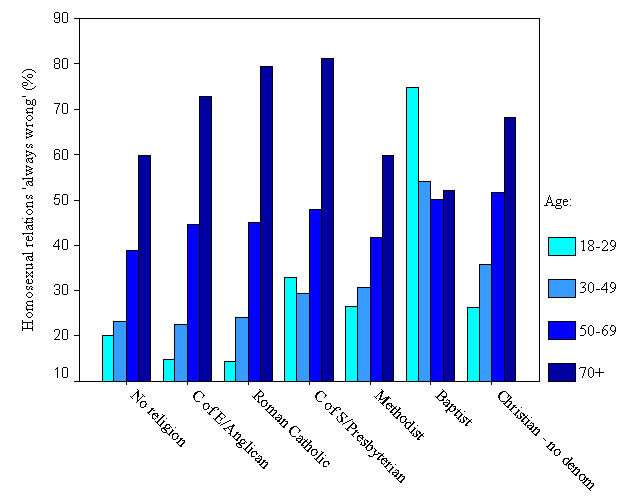
|
 How are attitudes
being passed on?
How are attitudes
being passed on?|
Table 4. 'Pro-gay' and 'anti-gay' attitudes of children by parental
attitude and religiosity (Wave 8 of the BHPS)
|
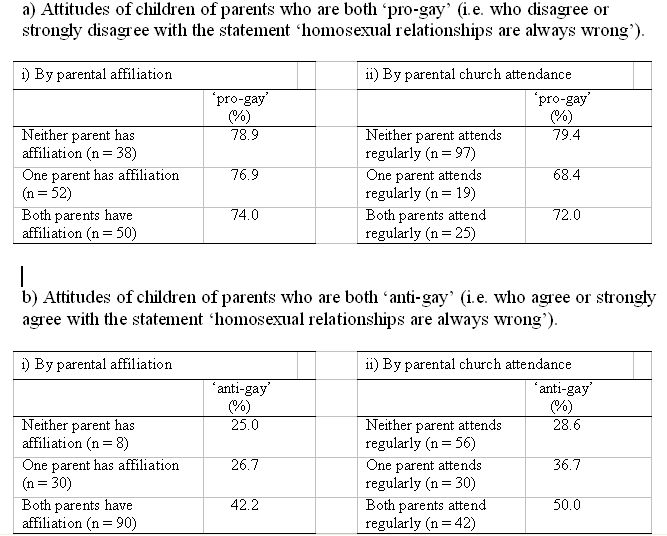
|
| Table 5. 'Anti-gay' attitudes by sex, generation and religiosity |
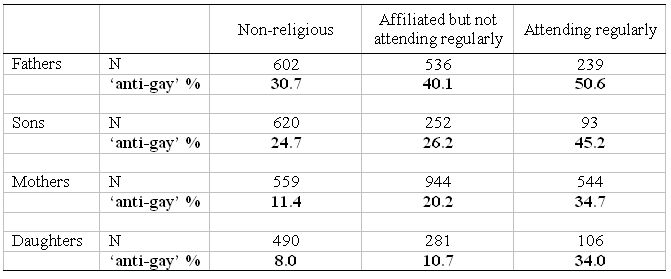 |
Note: Sons and Daughters comprise all individuals whose natural mother is also a BHPS panel member. Mothers and fathers are the parents of these children ('fathers' include current male partners of the mother). Persons in each generation are categorised separately (e.g. religious sons are not necessarily sons of religious fathers and/or mothers). 'Anti-gay' and religious characteristics of parents are defined as for Table 4. Religious characteristics of children were taken from Wave 9 (or Wave 7 then Wave 1 if the later wave had missing data).
 Conclusion
Conclusion Notes
Notes2 The source for this and all other BSA data analysed in this paper is: National Centre for Social Research, British Social Attitudes Survey, 1983 to 2000 [computer files]. Colchester, Essex: UK Data Archive [distributor]. SN 1935, 2035, 2096, 2315, 2567, 2723, 2840, 2952, 3439, 3572, 3764, 3921, 4072, 4131, 4318, 4486.
3 Since the focus is on Christianity, these and all subsequent tables and figures exclude the small but growing number of people with a different religion (4.7 percent of the weighted sample in 2000). In 1983-4, the attitudes of non-Christian religious adherents were similar to the sample as a whole: 55.3 percent thought homosexuality was always wrong, compared with 52.3 percent of the total sample. In 1999-2000 the attitudes of the non-Christian group were no more tolerant, opening up a gulf between non-Christian adherents and the general population: 56.3 percent of non-Christians thought that homosexuality was always wrong compared with just 37.3 percent of the total sample.
4 On a log scaled vertical axis (as in Figures 1 and 2), a constant vertical distance indicates a constant proportional difference (e.g. 100 is 10 times greater than 10 and 10 is 10 times greater than 1, so that the distance between 1 and 10 will be the same as that between 10 and 100).
5 As Scott (1998: 839) suggested, the gender gap may have closed in the late 1980s as a result of the AIDS shock, which may have differentially increased anti-homosexual views among women. Women were certainly more afraid of AIDS: in the 1987 BSA, 64 percent of women and 56 percent of men thought that AIDS would be killing more people in Britain than any other single disease in the next five years.
6 The odds ratio measures the probability of the characteristic (being 'anti-gay') in one group relative to another. An odds ratio greater than 1 implies that the characteristic is more likely in that group (e.g. men) than among the contrasting group (e.g. women). For an odds ratio less than 1, the reverse is true. Column 1 of Table 3 shows the log of the odds ratio; the odds ratio itself is in column 3. Each unit increase in the variable (e.g. each additional year of age) results in the odds of the characteristic (being 'anti gay') being multiplied by the amount shown.
7 The source for this and all other BHPS data analysed in this paper is: University of Essex. Institute for Social and Economic Research, British Household Panel Survey; Waves 1-11, 1991-2002 [computer file]. Colchester, Essex: UK Data Archive [distributor], May 2003. SN: 4651.
8 A similar question was asked in the 1996 and 1997 BSA, and the breakdown of responses is very similar to those obtained in Waves 8 and 10 of the BHPS.
9 Acceptance is defined as either disagreeing or strongly disagreeing with the statement that 'homosexual relationships are wrong', censure is defined as agreeing or strongly agreeing with the statement.
10 In the 1983-4 BSA data, 73.4 percent of those who thought that homosexuality was always wrong were Christians (and 68.1 percent of the sample was Christian). In 1999-2000, only 66.8 percent of those who thought that homosexuality was always wrong were Christian (but only 58.1 percent of the sample was Christian).
FINLAY B. and Walther, C.S. (2003) 'The relation of religious affiliation, service attendance, and other factors to homophobic attitudes among university students', Review of Religious Research, Vol. 44, No. 4, pp. 370-393.
KELLEY, J. (2001) 'Attitudes towards homosexuality in 29 nations', Australian Social Monitor, Vol. 4, No. 1, pp. 15-22.
SCOTT, J. (1998) 'Changing attitudes to sexual morality: A cross-national comparison', Sociology, Vol. 32, No. 4, pp. 815–845.